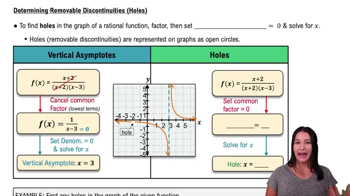Table of contents
- 0. Review of Algebra4h 16m
- 1. Equations & Inequalities3h 18m
- 2. Graphs of Equations43m
- 3. Functions2h 17m
- 4. Polynomial Functions1h 44m
- 5. Rational Functions1h 23m
- 6. Exponential & Logarithmic Functions2h 28m
- 7. Systems of Equations & Matrices4h 6m
- 8. Conic Sections2h 23m
- 9. Sequences, Series, & Induction1h 19m
- 10. Combinatorics & Probability1h 45m
5. Rational Functions
Asymptotes
Problem 53
Textbook Question
Identify any vertical, horizontal, or oblique asymptotes in the graph of y=ƒ(x). State the domain of ƒ. 
 Verified step by step guidance
Verified step by step guidance1
Identify the vertical asymptote by finding the value of x where the function approaches infinity or negative infinity. In the graph, this occurs at x = 6.
Identify the horizontal asymptote by observing the value that y approaches as x goes to positive or negative infinity. In the graph, this occurs at y = 6.
There are no oblique asymptotes in this graph as the function does not approach a line that is neither horizontal nor vertical.
State the domain of the function. The domain includes all real numbers except where the vertical asymptote occurs. Therefore, the domain is all real numbers except x = 6.
Summarize the findings: The vertical asymptote is at x = 6, the horizontal asymptote is at y = 6, and the domain of the function is all real numbers except x = 6.
Recommended similar problem, with video answer:
 Verified Solution
Verified SolutionThis video solution was recommended by our tutors as helpful for the problem above
Video duration:
5mPlay a video:
Was this helpful?
Key Concepts
Here are the essential concepts you must grasp in order to answer the question correctly.
Asymptotes
Asymptotes are lines that a graph approaches but never touches. Vertical asymptotes occur where a function approaches infinity, typically at points where the function is undefined. Horizontal asymptotes indicate the behavior of a function as x approaches infinity or negative infinity, showing the value the function approaches. Oblique asymptotes occur when the function approaches a linear function as x approaches infinity.
Recommended video:

Introduction to Asymptotes
Domain of a Function
The domain of a function is the set of all possible input values (x-values) for which the function is defined. It is crucial to identify any restrictions, such as values that lead to division by zero or negative square roots. Understanding the domain helps in analyzing the behavior of the function and its graph, particularly in relation to asymptotes.
Recommended video:

Domain Restrictions of Composed Functions
Graph Interpretation
Interpreting a graph involves analyzing its features, such as intercepts, asymptotes, and overall shape. This skill is essential for understanding the behavior of the function represented. By examining the graph, one can identify vertical and horizontal asymptotes, as well as the general trend of the function, which aids in determining the domain and range.
Recommended video:
Guided course

Graphs and Coordinates - Example

 6:24m
6:24mWatch next
Master Introduction to Asymptotes with a bite sized video explanation from Callie
Start learningRelated Videos
Related Practice








